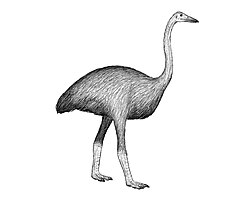Top Qs
Timeline
Chat
Perspective
Mullerornis
Extinct species of birds From Wikipedia, the free encyclopedia
Remove ads
Mullerornis modestus is an extinct species of elephant bird, and the only member of the genus Mullerornis.
Remove ads
Taxonomy
The genus is named after Georges Muller, a French explorer, who was killed in 1892 by hostile members of the Sakalava people.
Synonyms of Mullerornis modestus
- Mullerornis betsilei Milne-Edwards & Grandidier, 1894[2] (Betsileo elephant bird)
- Mullerornis agilis Milne-Edwards & Grandidier, 1894 (agile/coastal elephant bird)
- Mullerornis rudis Milne-Edwards & Grandidier, 1894[1] (robust elephant bird)
- ?Mullerornis grandis Lamberton 1934 (holotype destroyed in a fire in 1995)
Remove ads
Description

Mullerornis is smaller than the more well-known Aepyornis,[3][4] with a still substantial body mass of approximately 80 kilograms (180 lb).[5] A bone possibly belonging to Mullerornis has been radiocarbon dated to about 1260 BP,[6] suggesting that the animal was still extant at the end of the first millennium.[7] Aepyornis modestus was shown by Hansford and Turvey (2018) to be a senior synonym of all nominal Mullerornis species described by Milne-Edwards and Grandidier (1894), resulting in the new combination Mullerornis modestus.[8]
Remove ads
Palaeobiology
Nocturnality
Like other elephant birds and its kiwi relatives, Mullerornis probably was nocturnal based on the small size of its optic lobes, though it shows less optical lobe reduction than these other taxa, implying slightly more crepuscular habits.[9]
Diet
Isotopic evidence suggests that Mullerornis was likely a browsing herbivore.[10]
Reproduction
The eggs of Mullerornis are substantially smaller than those of Aepyornis, weighting approximately 0.86 kilograms (1.9 lb), with a shell thickness of about 1.1 mm (3⁄64 in).[5]
Footnotes
References
Wikiwand - on
Seamless Wikipedia browsing. On steroids.
Remove ads


